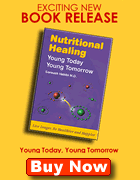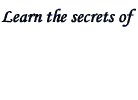 |
Macro-elements and Macro-minerals
Minerals and trace elements play a vital role in the well being of the cell.
For instance, selenium is essential in the glutathione peroxidase system. They
are only available in minute amounts in the soil as some soils are depleted
of these minerals. The soil is depleted due to overuse and insufficient fortification.
Most commonly, the soil is fertilised with nitrogen, phosphorous and potassium
(NPK). Plants, fruits and vegetables grow well with the addition of NPK to the
soil. However, the human body needs more than NPK for its optimal health. We
need zinc, copper, manganese and selenium to combat oxidative stress. If the
soil is deficient then our body will become deficient. In this chapter I am
going to explore the importance of these elements and minerals.
Macro-elements are substances that are available in the air and food. These
consist of oxygen, hydrogen, nitrogen, carbon and sulfur. They are present in
abundance in nature. These form 96% of the body. 6
Macro-minerals or trace elements are calcium, magnesium, phosphorus, potassium
and chloride, which form the remaining 4% composition of the body. 6
There are other minerals such as zinc, chromium and selenium, which are equally
important for the function of the cell.
Boron, Bo
Boron is essential for hormone production such as an active form of oestrogen
called 17 beta-oestradiol. 75
Oestrogen assists in bone preservation thus preventing osteoporosis. Moreover,
it is beneficial in osteoporosis by way of helping the function of vitamin D.
As well, it has been shown to improve osteoarthritis.
Food sources are almonds, soybeans, fruits and vegetables, dates, prunes and
raisins.
Treatment indications are:
- Osteoporosis and maintaining healthy bones
- Menopausal women
- Osteoarthritis
Dosage
RDA is not established yet.
EDR is 3-6 mg with the average of 3 mg per day.
Good forms are chelated, citrate or aspartate.
Toxicity
Boron has low toxicity. Doses above 50 mg per day can interfere with riboflavin
and phosphorus. 76
Calcium, Ca
Calcium is a mineral well known to the majority of people, especially menopausal
women. It is the most plentiful mineral in the body. Most of the calcium (90%)
is in the bones and teeth together with phosphorous, with the ratio of Ca: P=2:1
in bones. Calcium deficiency is a common medical presentation. This is due to
a low calcium diet, and insufficient absorption. For calcium to be absorbed
it needs acid pH to become soluble and even then only 20-30% gets absorbed through
the small intestine. Its absorption is also controlled by vitamin D through
calcium binding protein.
Good sources are green leafy vegetables, nuts, spinach, broccoli, peas, lentils,
kale, fish, egg yolk, milk and legumes.
Its main function is to build and maintain healthy bones and teeth. In addition,
it is involved in muscle contraction, blood clotting, and nerve conduction,
cell division, cell membrane permeability, transport of nutrients in and out
of the cell, iron utilisation and hormone secretion.
There are various forms including calcium carbonate (found in antacids), calcium
gluconate and lactate, and calcium citrate and citrate-malate. The citrate form
is the most bioavailable and best absorbed.
Dosage
RDA 800-1400 mg per day
EDR 1000-2000mg per day
Chromium, Cr
Chromium is involved in the metabolism of glucose. It improves insulin sensitivity
of the cell and therefore pushes glucose into the cell. As such it seems to
improve GTT (glucose tolerance test). 62
Chromium deficiency has been linked with heart disease.
Chromium protects against atherosclerosis, diabetes and improves corneal clarity.
It binds with RNA and assists in protein synthesis. 27
Our body absorbs chromium with difficulty and only 3% remains in the body.
Best sources are wheatgerm, black pepper, mushrooms, grape juice, asparagus,
nuts, oysters, liver and shrimp.
Chromium picolinate is the most absorbable form.
Chromium is indicated in the treatment of diabetes, infertility, high cholesterol,
hypertension, dry eyes, myopia and coronary heart disease (CHD). 27
Dosage
RDA 50-200 mcg per day
EDR 100-300mcg per day
Copper, Cu
Copper is essential in our natural antioxidant system-superoxide dismutase
(SOD)-thus protecting cell membranes from free radical damage. Copper is involved
in haemoglobin synthesis by converting ferrous iron to ferric iron. It is also
important for the absorption of iron. Copper plays a role in elastin and collagen
formation, which is important in tissue healing and skin elasticity.
Copper is absorbed in the upper intestine with 30% absorption rate, and the
rest is excreted via faeces and bile. Copper is mostly stored in the liver,
kidney, heart and brain.
Rich sources are liver, lamb, crab, oysters, pork, almonds, sunflower seeds,
leafy vegetables and mushrooms.
Copper is indicated in anaemia, high cholesterol, osteoarthritis, and cardiovascular
disease (CVD), haemorrhoids and hair loss.
Dosage
RDA 1.5-3 mg per day
EDR 2-5mg per day
Iodine, Iodide, I2
Iodine is a key factor in thyroxine production by the thyroid gland. Thyroxine
is vital for cell metabolism and energy production. Thyroxine is necessary for
growth and also burns fat.
Sources are iodised salt, kelp, seafood, lamb, liver, pineapple, spinach, raisins
and lettuce.
Indications are prevention of goitre and cretinism (type of growth retardation).
Dosage
RDA 150-200 mcg per day
EDR 100-200 mcg per day
Iron, Fe
Iron deficiency is the most common trace element deficiency in both the developing
countries and the developed world79.
About 20% of menstruating women in the developed countries suffer from iron
deficiency anaemia61.
As calcium is the most abundant mineral in the body, iron is the most abundant
trace element in the body. Its main function is synthesis of haemoglobin, which
is a red pigment in the red blood cells carrying oxygen from the lungs to the
various parts of the body. Thus, it has an important role in respiration. In
addition, it is vital for growth, production of neurotransmitters, immune system,
hair, skin and nail formation.
For iron to function properly it needs calcium and copper. The most bioavailable
form is haeme, which is found in red meat.
Good sources are liver, heart, kidney, red meat, oysters, egg yolk, parsley,
pumpkin seeds, sunflower seeds, apricots, grapes and soybeans. Poor sources
are milk, sugar, potatoes and fresh fruits.
It is absorbed in the upper small intestine, and this is facilitated by vitamin
C by reducing ferric to ferrous iron.
Treatment indications are iron deficiency anaemia (IDA), pregnancy, bleeding,
hair loss, brittle nails, infection, lethargy, learning difficulties and colitis.
Dosage
RDA 10-20 mg per day
EDR 15-150 mg per day
Toxicity
Too much iron is toxic and as such should be taken with care. It should be
kept out of children's reach. Doses above 30-70 mg per kg in body weight are
dangerous and may cause liver damage, fatigue, arthritis, Parkinson's disease
and even coma.
|
 |
Magnesium, Mg
Magnesium is the most natural calcium-channel blocker and therefore it is recommended
in treating patients with high blood pressure.
Magnesium is involved in more than 300 enzymatic reactions including ATP and
alkaline phosphatase (ALP). It is estimated that about 50-60% of magnesium is
in the bone, some is inside the cell and only a very small amount (0.3%) is
in the serum (blood circulation). Therefore, measurement of serum magnesium
does not pick early magnesium deficiency. That is why magnesium deficiency is
commonly under diagnosed.
Magnesium is involved in the function of mitochondria and therefore energy
production. It is required with calcium for bone mineralisation. It is involved
in the biochemical process which helps to stabilise the molecular structure
of RNA and DNA. It is necessary for glucose metabolism and energy production.
It is involved in the synthesis of lecithin, neurotransmitters, and nucleic
acid. It is required for the function of thiamin. It also regulates the metabolism
of sodium, potassium, calcium and phosphorous.
Good sources are figs, apples, almonds, soybeans, cashew nuts, tofu and green
leafy vegetables such as spinach, peas and beans. The greener the vegetable
the more magnesium content.
Treatment indications
- It is used in diabetes and diabetic retinopathy. 66
- It is used in pregnancy and lactation, PMS (premenstrual syndrome), dysmenorrhoea
(painful period) and toxaemia of pregnancy
- It is used in asthma due to bronchial smooth muscle relaxation. 67
- It is used in heart conditions such as angina, infarction, congestive heart
failure, irregular heartbeats, palpitations and hypertension. 63, 64
- It is used in the treatment of migraine and tension headaches. 65
- It is also used in CFS (chronic fatigue syndrome), neuromuscular disorders,
anorexia nervosa, depression, tremor, cramps, kidney stones and osteoporosis.
Dosage
RDA 270-320mg per day, 270mg for women and 320mg for men.
EDR 300-1000mg per day.
The average dose is 400mg per day.
Manganese, Mn
Manganese is involved in a number of vital enzyme processes within the body.
It is essential in the superoxide dismutase antioxidant system (SOD) to prevent
lipid peroxidation. It is required for the production of thyroxine, cholesterol,
fatty acids, RNA and glutamine. It has a role in glucose metabolism and energy
production. It is essential in synthesis of mucopolysacharides, which are vital
for cartilage and joint growth and lubrication. Manganese is involved in the
synthesis of proteoglycan molecules, which are building blocks of cartilage
formation and improves the structure of the bone. Manganese seems to be low
in women with osteoporosis. 68
Manganese is important in the function of the nervous system in particular
the vestibular system.
Food sources are tea, leafy green vegetables, walnuts, sunflower seeds, almonds,
olives, corn, and whole grains.
Treatment indications
- Vestibular dysfunction such as dizziness and loss of balance
- Diabetes and hypoglycaemia as it regulates carbohydrate metabolism
- Musculo-skeletal conditions like tennis elbow, RSI and osteoporosis
- Hearing loss, tinnitus, low fertility, myasthenia gravis and schizophrenia.
27
Dosage
RDA is 2.5-5 mg per day
EDR is 5-50 mg per day with the average of 5-10 mg on daily basis.
Toxicity
Manganese is very safe in recommended doses. However, it can become toxic in
miners who are overexposed to it or as a result of excessive dietary exposure.
It can affect the central nervous system.
Molybdenum, Mo
Molybdenum is an important trace element involved in the process of oxidation-reduction.
It is involved in xanthine oxidase, which reduces uric acid formation. The other
enzyme is aldehyde oxidase, which oxidises fat and detoxifies purines, pyrimidines
and similar substances.
Food sources are cereals, green leafy vegetables, milk legumes and meat. Molybdenum
is totally soil dependent, thus if the soil is deficient it will not be found
in the fruits grown in the area. Molybdenum is diminished with food processing.
Treatment indications
- Prevention of anaemia
- Detoxifying cancer related chemicals
- Male impotence
- Dental caries.
Dosage
RDA is 75 mcg per day
EDR is 60-500 mcg per day
Toxicity is uncommon, but high doses may cause toxicity.
Selenium, Se
Selenium is a diverse trace element with several health benefits. The problem
is that selenium is soil dependent and soil in some countries is depleted of
selenium. The other problem is that even if the selenium level of the soil is
sufficient, the sulfur containing fertilisers and sulphuric acid inhibits its
absorption. When it is combined with vitamin E it makes vitamin E 50 times more
potent as an antioxidant. 27
Selenium is involved in the glutathione peroxidase system, which is the most
important antioxidant system within the cell. Selenium is required for conversion
of thyroid hormones T4 to T3. Selenium maintains and protects the cell membrane
by preventing lipid peroxidation. It enhances the immune system via phagocytosis
and promoting T-cells. Selenium also regulates the prostaglandin synthesis,
it detoxifies chemicals, and prevents platelet aggregation. It is essential
for sex hormones and reproduction. A great deal of selenium is lost during intercourse
as sperm contains high levels of selenium. Therefore, men have greater selenium
requirements than women.
Selenium has two forms organic (selenomethionine, selenocysteine, selenocystine
or Se-methyl selenomethionine), which is less toxic and more easily absorbed
by the body, and inorganic (selenite or selenate). 27
Selenium deficiency has been linked with Kashin-Beck's disease, which is a
joint disease.
Food sources are garlic, alfalfa, peanuts, cashews, cereals, fish, oysters,
crab, liver, kidney and human breast milk.
Treatment indications
- Asthma and arthritis by controlling arachidonic pathway and limiting the
inflammatory response.
- Prevention of several forms of cancer such as prostate, colon, oesophagus
and lung. 69
- Mercury, cadmium, silver and thallium poisoning by inhibiting absorption
and increasing excretion.
- Cardiovascular disease including, angina, stroke, heart attack and hypertension.
70
- Many more conditions like cystic fibrosis, MS, dandruff, alcoholism, diabetes,
and liver disease.
Dosage
RDA is 70-85 mcg per day
EDR is 200-400 mcg per day with the average supplementation of 200mcg per day.
Toxicity
Selenium can be toxic in doses of 5mg per kg body weight in an acute form,
and in chronic form 1 mg per day. Toxicity can cause irritability, garlic breath
odour, lethargy, hair loss, liver damage and birth defects.
Zinc, Zn
Zinc is involved in over 300 enzyme processes including DNA and RNA polymerase,
which controls protein synthesis in all cells within the body. It is an integral
part of SOD/ superoxide dismutase antioxidant system.
Except for iron it is the only trace element found in the greatest amount in
the body. It is necessary for the absorption of vitamin A and the B group. It
forms part of DNA, which is important for gene expression. Zinc is essential
for natural taste and smell perception, cell membrane integrity, wound healing,
mental function and brain development. It is also necessary for collagen formation.
Zinc is involved in the conversion of retinol to retinal, which is important
for vision.
It is absorbed in the upper part of the small intestine, and is facilitated
by the secretion of picolinic acid from the pancreas.
Good sources are almonds, peanuts, walnuts, hazel nuts, pecans, ginger roots,
sunflower and pumpkin seeds, oysters, chicken, meat, egg yolk, soy lecithin,
carrot, rye, oats, parsley, corn and potatoes.
Treatment indications
- Pregnancy and lactation
- Skin conditions like acne, dermatitis, dandruff and alopecia
- Nervous system conditions such as epilepsy, anorexia nervosa and bulimia
and schizophrenia
- Infertility, oligospermia (low sperm count) 71, renal disease and prostatism
- It is also good for cancer management and enhancement of the immune system
72 , Alzheimer's disease 74 , rheumatoid arthritis, atherosclerosis, cystic
fibrosis and diabetes.
- It is beneficial for Crohn's disease, coeliac disease, pancreatitis, and
cirrhosis.
- It is recommended in cadmium and copper toxicity. 27
- Night blindness and macular degeneration. 73
Dosage
RDA is 12-15 mg per day.
EDR is 10-100mg with the average of 20-30 mg.
The best forms are zinc picolinate or chelated zinc.
Toxicity
Doses of more than 1000mg in adults are toxic and may cause nausea, vomiting,
diarrhoea, lassitude and poor growth.
For more detailed information and specific recommendations, please [click here] to become a member of DrHabibi.com
|
 |




